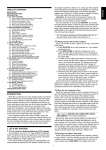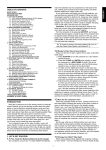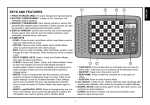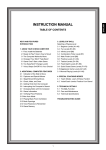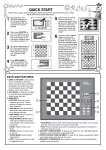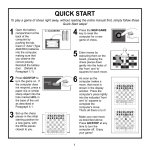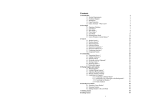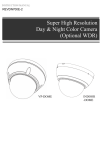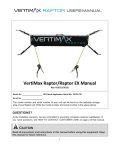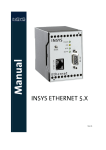Download Saitek Bullet Specifications
Transcript
1. PROTECTIVE COVER: Detachable, hinged lid keeps dust out and keeps pieces in place during travel. 2. BATTERY COMPARTMENT: In base of unit. Uses four “AA” (Type AM3/R6) alkaline batteries. 3. SENSORY CHESSBOARD: Each square contains a sensor that registers piece movement. 4. GAME KEYS • NEW GAME: Press to reset for a new game of chess. • LEVEL: Press to enter Level Mode, when pressed together with a piece symbol key, to access the Teach Modes. • NON AUTO: Press to enter Non Auto Mode, which allows moves to be entered manually. • VOICE COACH: Press to select Voice Coach Level options. • EVALUATE: Press while the computer is thinking to get the computer’s evaluation of the current board position. • TAKE BACK: Press to take back the last individual move. Take back up to six individual moves (three per side). • SAY AGAIN/DISPLAY MOVE: Press when it’s your turn to have the last voice output repeated. Press and hold down while the computer is thinking to display the move it is considering. • SMART HINT: Press to get a level-independent move suggestion. • PLAY: Press to change sides with the computer; press while the computer is thinking to force it to move. Press at the beginning of a new game to play Black from the bottom of the board. • PIECE SYMBOL KEYS: Used for piece verification and pawn promotion; also used to select Teach Modes. • VOLUME SLIDER: Used to turn the volume up and down. • GO/STOP: Used to turn the computer on and off. Current position is retained in memory even when turned off. 5. ACL (Reset): In base of unit. Used to eliminate static discharge after inserting new batteries. 6. BOARD LIGHTS: Used to show moves and game information, verify pieces, indicate the side to move, and show the playing levels. Also used to indicate check, mate, and draw, and to give you insight into the computer’s thought process. 7. PIECE STORAGE AREA: For storage of captured pieces. 8 7 6 NEW GAME LEVEL PLAY VOICE COACH EVALUATE TAKE BACK SAY AGAIN SMART HINT NON AUTO 5 4 DISPLAY MOVE 3 2 VOLUME 1 STOP • A CHECK B C D DRAW E F G MATE H • GO A PORTABLE CHESS COACH THAT TALKS — what a great way to learn about chess! 1 ENGLISH KEYS AND FEATURES AT A GLANCE suggest a visit to your local library, where you are sure to find a wealth of interesting chess books! TABLE OF CONTENTS INTRODUCTION 1. GETTING STARTED: THE BASICS 1.1 First, Install the Batteries 1.2 Ready to Play? Here’s How! 1.3 The Computer Makes Its Move 1.4 Change Your Mind? Take Back! 1.5 Game Over? Start a New Game 1.6 Too Easy/Hard? Change Levels! 1.7 Voice On/Off? It’s Your Choice! 2. ADDITIONAL FEATURES 2.1 Indication of the Side to Move 2.2 Captures and Special Moves 2.3 Illegal Moves/Wrong Moves 2.4 Check, Mate, and Draw 2.5 Need Help? Ask for a Hint! 2.6 Interrupting the Search 2.7 Changing Sides with the Computer 2.8 Game Information 2.9 Verifying Piece Positions 2.10 Non Auto Mode 2.11 Playing Black from the Bottom 2.12 Book Openings 2.13 Game Memory 3. LEVELS OF SKILL Selecting a Playing Level 3.1 Beginner Levels 3.2 Fun Levels 3.3 Infinite Level 3.4 Combination Finder Level 3.5 Mate Finder Level 3.6 Practice Levels 3.7 Tactical Levels 3.8 Fixed Depth Levels 3.9 Quiet Closed Game Levels 3.10 Aggressive Game Levels 3.11 Normal Playing Levels 1. GETTING STARTED: THE BASICS 1.1 First, Install the Batteries Your computer runs on four “AA” (AM3/R6) batteries. For longer battery life, use fresh alkaline. Slide the GO/STOP switch to GO, and then insert the batteries as shown in the Quick Start. After a short selftest, a Welcome message will greet you, signalling that the computer is ready to play! If the unit doesn’t respond, reset the computer by using a paper clip or another sharp object to press into the hole marked ACL in the base of the unit for at least one second. See “KEYS AND FEATURES AT A GLANCE” for an itemized overview of your chess computer’s main points! 4. SPECIAL COACHING MODES 4.1 Voice Coach Levels 4.2 Teach Modes 1.2 Ready to Play? Here’s How! Follow these steps to start a game: a. Switch to GO to turn the unit on, if you haven’t already done so. b. Set up the pieces in their starting positions, with the White pieces nearest to you, as shown in the Quick Start. Press NEW GAME; the computer confirms by announcing New Game. c. To make a move, lightly press down on the piece you want to move until you hear the voice identify that piece. The sensory chessboard registers your move, and two board lights turn on to indicate the piece. d. Take the piece and gently press it down into the hole of the square you want to move to. A beep will sound, and the computer will then start thinking about its move. At the beginning of a game, the computer often replies instantly on many levels, playing moves directly from its openings library (see Section 2.12). 5. TECHNICAL DETAILS 5.1 The ACL Function 5.2 Care and Maintenance 5.3 Technical Specifications TROUBLESHOOTING GUIDE INTRODUCTION Thank you for choosing this unique computer as your new chess partner and opponent. This chess computer will give you countless hours of valuable chess instruction and exciting game play! As the computer patiently guides you and teaches you about this great game, your chess skills are bound to improve. The voice will follow your every move, occasionally even offering helpful advice and encouragement. This is interactively at its best—watch, listen, and learn as you play! Your computer knows the rules of chess. For those who are new to the game, we have enclosed an overview of the rules. We hope this will help you to understand the game better and get a feel for the strategies involved. For more detailed information and further study, we 1.3 The Computer Makes Its Move When the computer moves, it beeps and turns on two board lights indicating the horizontal row and vertical column of the piece it wishes to move. Press this piece down gently on the square. The computer then uses the board lights to show you where the 2 ever, if you would rather not have the voice on, you have other options! As noted in Section 4.1, you can choose to hear only beeps, or even turn the sound off for completely silent operation, if desired. By the way, if you don’t hear what the computer says, simply press SAY AGAIN on your turn to have the last message repeated. Note the following exceptions: If you press SAY AGAIN in Verify Mode or when the computer is displaying a hint on your turn, the computer will simply return to normal playing mode. Also, SAY AGAIN is disabled if the Voice Coach Level is set to G or H, or when you are in Level Mode. See the “QUICK START” for an example of how the board lights would indicate a computer move from e7 to e5! 1.4 Change Your Mind? Take Back! If you make a mistake or change your mind about a move, it’s easy to take moves back! Press TAKE BACK when it is your turn, and the computer will announce the move to be taken back (e.g., Black takes back Knight move). The computer also uses board lights to guide you through the take-back. The to square of the last move lights first— press the indicated piece down on that square. The computer then shows you where the piece came from. Press the piece down on the from square to complete the take-back. Repeat this procedure to take back more moves, up to a total of six individual moves. When taking back captures or castling maneuvers, the computer will remind you which pieces should be put back on the board! It does so by turning on board lights to indicate the position. It also announces the color and type of the captured piece. 2. ADDITIONAL FEATURES 2.1 Indication of the Side to Move When Black is thinking about its move, board light 8 flashes. After it has moved, the 1 light comes on steadily to show that it is now White’s turn to move. Similarly, if the computer plays White, the 1 light flashes during its turn, and the 8 light comes on steadily after it has moved. It’s easy to tell whether the computer is thinking and whose turn it is! 2.2 Captures and Special Moves During the game, the computer’s voice will normally alert you to captures and special moves, such as castling or pawn promotions. Captures: To capture, press down lightly on the piece you want to move—the voice will identify that piece. Take the captured piece off the board, and press your piece on the square of the captured piece. The capture will be announced, as in takes Bishop. En Passant: In an en passant capture, the computer uses board lights to remind you to remove the captured pawn. Press down on the captured pawn before removing it from the board. Although beginning players are often confused when this type of capture occurs, the voice output takes pawn en passant is heard after pressing the to square— making this move unmistakable! Pawn Promotion: • When you promote a pawn, first press your pawn down on its from square, as usual. As soon as you press down on the to square, you will hear Pawn now Queen—and your pawn automatically becomes a Queen! If you would rather underpromote to a Knight, Bishop, or Rook, first press the from square. Then, before pressing the to square, press the Piece Symbol key for the Knight, Bishop, or Rook. 1.5 Game Over? Start a New Game Whenever you finish a game (or if you decide to abort your current game), press NEW GAME to reset the computer. The computer is then ready for another game, using the currently selected level. Caution: Since pressing NEW GAME clears your current game from memory, be careful not to press this key by mistake! 1.6 Too Easy/Hard? Change Levels! When the computer is first turned on, it is set to Level H4 (ten seconds a move). However, you may choose any of the 64 playing levels described in Section 3! Press LEVEL to enter Level Mode, and the board lights will indicate the current level. To change levels, press a board square to activate your desired level, using the Level Chart in Section 3 as a guide. Press LEVEL again to exit Level Mode. 1.7 Voice On/Off? It’s Your Choice! Your computer’s informative and entertaining voice output is on by default, and the Volume Control Slider sets the desired volume. How- 3 ENGLISH piece should go. Move the piece to the indicated square and press the piece down. Once you have pressed this square, you have completed the computer’s move! Finally, press down on the to square. You will hear Pawn now [piece]. Remember to change your piece on the board or make a distinguishing mark on the pawn. • When the computer promotes a pawn, it first indicates its move as usual. As soon as you press its from and to squares, it will announce Pawn now Queen if it is promoting to a Queen. When the computer underpromotes, first press its from and to squares as usual. After the underpromotion is announced (Pawn now Bishop, for example), and the to square flashes, press the corresponding Piece Symbol key (the BISHOP key, in this case) to acknowledge the underpromotion, and the to square lights will turn off. If you have the voice turned off and the computer underpromotes, check its chosen piece by pressing the Piece Symbol keys in succession—the key which turns the flashing to square off indicates the correct piece. Don’t forget to replace the computer’s pawn with its new piece or make a distinguishing mark on it. Castling: The computer automatically recognizes castling after the King is moved. After you have pressed the King down on its from and to squares, the computer announces Castling, and uses board lights to remind you to move the Rook. Press down on the Rook’s indicated from and to squares to finish the castling move. 2.4 Check, Mate, and Draw When your King is in check, the computer says Check! and flashes the A and B board lights. When a game ends in mate, Checkmate! is announced, followed by Good game! Play again? if the computer loses, or simply Play again? if you have lost. The A, B, G, and H board lights will also flash. The computer recognizes draws by stalemate and consecutive three-fold repetition. When either a stalemate or consecutive three-fold repetition draw occurs, the voice says Draw! Play again?, and the D and E lights flash. 2.5 Need Help? Ask for a Hint! Whenever you need help, press SMART HINT on your turn, and the computer will give you a move suggestion! If it thinks moving your Knight from g1 to f3 is the best move, for example, it uses the board lights to indicate that move, and tells you to Move Your Knight! Note that you will get a hint in around five seconds no matter which level you are on, since the hint move is based on a special “Best Play Level” rather than the current level. So—you’ll always get immediate feedback whenever you’re in need of assistance! To accept the hint as your move, simply make the suggested move on the board. If you would rather make a different move, disregard the hint and press another piece to make a move of your own. 2.3 Illegal Moves/Wrong Moves Your computer will never accept an illegal move. If you attempt such a move, the computer will announce your error! If you press the wrong to square, you hear Illegal move—and the board lights continue to indicate the square the piece came from. To clear the illegal move, either move that same piece to another square, or press it back down on its from square and move a different piece. If you press on the wrong color piece, you will hear Black [piece type] or White [piece type] – Illegal Move. Check the side to move and make the move correctly. If you don’t execute a computer move correctly (if you move the wrong piece, or move the computer’s piece to the wrong square), you hear a triple beep. Check the lights, and move the piece correctly. If you press a piece down on a from square but decide not to make that move, press down on the same square again to cancel the input. Then make another move. If you change your mind after entering your whole move, take the move back as described in Section 1.4. 2.6 Interrupting the Search To interrupt the computer while it is thinking, press PLAY—it will then play the best move it has found so far. This feature can be very useful on the higher levels, where the computer can take a long time to move, and on the Infinite Level, where it keeps thinking indefinitely unless you stop it! On the Mate Finder and Combination Finder Levels, pressing PLAY does not cause the computer to make a move. Instead, it sounds a double beep to indicate that it was interrupted before it found a mate or solution. To continue your game, switch to another level. 2.7 Changing Sides with the Computer To change sides with the computer, press PLAY when it is your turn to move—and the computer will make the next move for your side. To have the computer play against itself, simply press PLAY after each move—watch as it plays for both sides of the board, one move after another. Study its strategies—you might improve your own game! 4 WATCH THE COMPUTER THINK! • Press EVALUATE while the computer is thinking to see which side is ahead! • Press and hold down DISPLAY MOVE while the computer is thinking to see the move it’s currently thinking about! For more details, see Section 2.8. See “WATCH THE COMPUTER THINK!” for a quick reminder of which keys activate these special features! Position Evaluation: To get the computer’s evaluation of your position, press EVALUATE while the computer is thinking. Note that the evaluation feature is not valid on the Mate Finder and Combination Finder Levels, because of their special search algorithms. Positions are evaluated on a scale from 1 to 8, as indicated by board lights 1 through 8. In a balanced position, for example, board lights 4 or 5 may be on. If the side playing from the bottom improves its position, lights 6, 7, or 8 may come on. Light 8 represents a great material advantage for the side playing from the bottom—most probably a won position! When the computer thinks the side playing from the top has a won position, board light 1 turns on. Watch the evaluation change as the computer searches deeper and considers more moves! Display Computer’s Current Move: To see the move the computer is currently considering, press and hold down DISPLAY MOVE while the computer is thinking. The move is indicated with flashing board lights—the from and to squares flash alternately. Watch carefully, and you may see the computer change its mind about a move! Note that Display Move is not available on the Mate Finder and Combination Finder Levels. EVALUATE DISPLAY MOVE PRACTICE USING VERIFY MODE! 1. PRESS LIGHTS ON VOICE NEW GAME 1 New Game New game A + 1 White Rook 1st White Rook 2. DESCRIPTION (on) 3. H + 1 White Rook 2nd White Rook 4. A + 8 Black Rook 1st Black Rook Black Rook 2nd Black Rook (flashing) 5. H + 8 6. (Double beep—no more Rooks on the board) 7. 2.9 Verifying Piece Positions See “PRACTICE USING VERIFY MODE!” for an illustrated example—follow the steps, and you’ll see how easy it is! Any key Exit by making a move or pressing any other key lights indicate White pieces, and flashing lights indicate Black pieces. Press the same Piece Symbol key repeatedly to see the locations of more pieces of that same type. When there are no more pieces of that type, a beep will sound. Repeat this procedure using the other Piece Symbol keys, verifying the entire board, if desired! Since the voice announces the pieces as you move them during the game, the voice can also be used for a quick verification! Pressing any If you should knock over the pieces, or if you think your position might be wrong, you can have the computer verify the piece locations for you! On your turn, press one of the Piece Symbol keys. The computer will identify that piece by name, and it will use the board lights to show where the first piece of that type is located. Steadily lit board 5 ENGLISH 2.8 Game Information In a normal game of chess, you would never ask your opponent what move he was thinking about, nor would you question him as to how he would evaluate the current position. When playing against this chess computer, however, you can do just that! Upon request, it will show you the move it is considering and evaluate the position for you. Studying this information can help you to learn more about chess! one of your pieces when it is your turn to move identifies that piece (e.g., Queen). If the piece you have pressed is not the piece you are currently intending to move, simply press that piece again to turn its board lights off; then make another move of your choice. Pressing down on any one of your opponent’s pieces also identifies that piece, along with its color (e.g., Black Bishop – Illegal move). TRY BLACK FROM THE BOTTOM! If you play Black from the bottom as described in Section 2.11, make sure you set up the board like this! RyxwvutsrS 1JBIFKCHD1 2AGAGAGAG2 3MmMmMmMm3 4mMmMmMmM4 5MmMmMmMm5 6mMmMmMmM6 7gagagaga7 8dhcleibj8 TyxwvutsrU 2.10 Non Auto Mode Normally, the computer automatically answers with a countermove whenever you enter a move. If you press NON AUTO to enter Non Auto Mode, however, you can enter any number of moves one by one, without allowing the computer to answer! This feature can be used in a number of unique ways: • Play through master chess games. Press PLAY to see what the computer would do in any position! Use DISPLAY MOVE and EVALUATE to gain insight into the computer’s thoughts! • Study opening book lines by entering them manually! • Play against a friend, with the computer acting as referee by checking all moves for legality. If you need help with a move, press PLAY and the computer will make the next move. After it has moved, Non Auto Mode remains in effect, and you can continue your game. • Replay to any board position for further study. Keep records of your own chess games. When a game is over, play to certain positions to see how other moves or different strategies might have affected the outcome—watch and learn! Entering Non Auto Mode is confirmed by a beep. To exit this mode and return to normal play, press NON AUTO again. A double beep will verify that this mode has been cancelled. Note that Non Auto Mode is also automatically cancelled whenever you press NEW GAME or select one of the Teach Modes. top of the board! In “TRY BLACK FROM THE BOTTOM” diagram, you can see that the initial piece setup is different when you reverse sides. Notice, in particular, that the Kings and Queens are positioned differently. When you play Black from the bottom, the color indicators are also reversed—the 1 light indicates Black, and the 8 light indicates White. 2.12 Book Openings At the beginning of a game, the computer often replies instantly on many levels, because it is playing moves from its openings library. The computer’s library includes the major openings and many positions from Grandmaster play. If the current board position is in this library, the computer plays a response to that position from memory, instead of thinking about the move. The openings library is used on all levels except A1-A8 and B1-B8 (the Beginner/Fun levels, and the special problem solving levels). Many players typically know just five or six opening lines. Your chess computer will allow you to study and learn over 100 moves of solid, Grandmaster-approved opening theory! Try playing 1.c2-c4, 1.d2-d4, or even 1.Ng1-f3! 2.11 Playing Black from the Bottom See “TRY BLACK FROM THE BOTTOM!” for a diagram that shows you how to set up this special board position! You may want to depart from the usual standard and play the Black pieces from the bottom of the board, letting the computer play White from the top. To do this, press NEW GAME and then PLAY. The computer reverses sides and makes the first move for White from the 6 HERE’S HOW TO SET A LEVEL! Let's say you want to set the easiest Fun Level. Just follow the steps below: 1. Press LEVEL. Next, look at the Chart of Playing Levels and find the Fun Levels. You’ll see that Fun Level 1 is on Square B1. 3. LEVELS OF SKILL With 384 level settings to choose from (incorporating the Teach Modes), you can learn and grow with this chess computer! As shown on the Chart of Playing Levels, there are 64 unique playing levels— including levels for casual play, mate finder and combination finder levels, aggressive and quiet closed levels, and several different types of levels meant especially for beginners! When you set the level, keep in mind that when the computer has more time to think about its moves, it gets stronger and plays better—just like a human chess player! 2. Take a piece and press it briefly into the hole on Square B1 to select that level. You’ll see the B and 1 lights turn on, indicating Fun Level 1. See the “CHART OF PLAYING LEVELS” to get an overview of all the levels at a glance. We’ve also included level selection tips! LEVEL 1 A 3. Press LEVEL again to exit Level Mode. Now you can start playing on your newly selected level! Selecting a Playing Level Press LEVEL, and the computer lights the board square corresponding to the currently set level. When the computer is first turned on, it is set on Level H4 (ten seconds per move). As indicated in the chart, each of the 64 board squares corresponds to one playing level. After pressing LEVEL, press a square to activate a level, using the chart as a guide. When you press down on the desired square, the board lights will indicate that square. Press LEVEL to exit Level Mode. B LEVEL For details on all the levels, see Section 3. 3.1 Beginner Levels BEGINNER LEVELS See “HERE’S HOW TO SET A LEVEL!” for a step-by-step look at setting a specific level, AVERAGE TIME PER MOVE Square A1 ............................ Square A2 ............................ Square A3 ............................ Square A4 ............................ Square A5 ............................ Square A6 ............................ Square A7 ............................ Square A8 ............................ For levels indicating Average Response Times, note that the times are averaged over a large number of moves. In the opening and endgame, the computer tends to play faster, but in complicated middlegame positions, it may take longer to move. 7 1 second 2 seconds 3 seconds 4 seconds 5 seconds 6 seconds 7 seconds 8 seconds ENGLISH 2.13 Game Memory You may interrupt a game at any time by switching to STOP to turn the computer off. Play is suspended, and the computer will “remember” your position for up to two years (with fresh alkaline batteries). When you switch on again, continue where you left off! To conserve batteries, switch off when you interrupt a game for more than a few minutes. The Beginner Levels are meant specifically for novice players. Here, the computer restricts its search so that it deliberately plays weaker and gives the beginning player a chance to beat the computer! actually give away material—here, it plays more like a beginner who has learned the basics of the game. On this level, the computer makes mistakes such as bringing out its Queen too early, leaving its pieces unguarded, and opening itself up to threats of check or checkmate. Why not try out all the Fun Levels—and learn from the computer’s mistakes! 3.2 Fun Levels FUN LEVELS AVERAGE TIME PER MOVE Square B1 ............................ 1 second Square B2 ............................ 2 seconds Square B3 ............................ 3 seconds Square B4 ............................ 4 seconds Square B5 ............................ 5 seconds The unique “Fun Levels” are meant especially for beginners and young players—these levels will allow those who might otherwise never win a game of chess to come up on the winning side for a change! On the Fun Levels, your chess computer is much more “human” than most chess computers—it gives everyone a chance to win, in a world where chess machines are typically relentless and often quite difficult to beat. Although the general consensus seems to be that computers never make mistakes, on the five Fun Levels, this computer actually does! Various handicaps are built into the Fun Levels, demonstrating common mistakes made by beginners. Chess books often advise of basic rules—warning not to give away material, not to bring the Queen out too early, and advising the development of pieces before starting an attack. Yet players see their opponents breaking these rules and getting away with it! The Fun Levels provide a way of practicing the punishment of these typical mistakes, thus enabling the beginner to strengthen his game against the human opponents he is likely to face. Even after a player has mastered all the Fun Levels, they can still be a valuable training tool. A game can be started on a Fun Level, for example, and, when the computer makes a bad move, the player can switch to a normal level and try to convert his advantage to a win, playing against the stiffer opposition of a higher level. Level B1 is the weakest Fun Level. Here, the value of material is set so that the computer will not only “hang” its pieces (leave its pieces unguarded), but will also actually try to lose material. Watching the computer throw away its Queen would not even be uncommon on this level! Levels B2, B3, and B4 are similar to B1, in that they also give away material, but they do not do it as consistently. They consider the material worth of pieces more and more, and Level B4 only occasionally gives pieces away. On Fun Level B5, the computer does not 3.3 Infinite Level INFINITE LEVEL TIME PER MOVE Square B6 ........................ No time limit On the Infinite Level, the computer searches indefinitely, until it finds a forced mate, run out of memory, or you stop the search by pressing PLAY. If the search is halted, the computer makes the move it currently thinks is best. Experiment—let the computer analyze positions for hours or days! 3.4 Combination Finder Level COMBINATION FINDER LEVEL PURPOSE Square B7 ................. Solves chess puzzles The Combination Finder Level is used for solving “mate or a large win of material” problems. Here, the computer looks for the shortest forced win of two pawns or more. In order to come up with a solution, the computer must see a win of enough material to be two pawns better than the current position. If it finds such a solution, it beeps and indicates its move. If the computer reaches its search depth limit without finding a solution, it beeps and the previously flashing color indicator turns on steadily. To continue play, change levels—then either press PLAY to have the computer move or make a move of your own. 3.5 Mate Finder Level MATE FINDER LEVEL PURPOSE Square B8 ................ Solves mate problems If you have a position where there might be a mate and you want the computer to find it, set the computer on this level! It will search for a forced mate, and will only play a move if it finds a mate. The computer can solve mates in up to four moves. If there is no mate present or if the computer can’t find a mate, it beeps and the previously flashing color indicator turns on steadily. Continue play by changing levels. 8 8 A B C D E F G H Beginner Level 8 Mate Finder Level Practice Level 8 Tactical Level 8 Fixed Depth Level 8 Aggressive Game Level 8 Normal Play Level 8 3 min/move Search depth 8 ply Quiet Closed Game Level 8 3 min/move 3 min/move 3 min/move Quiet Closed Game Level 7 Aggressive Game Level 7 Normal Play Level 7 2 min/move 2 min/move 2 min/move Quiet Closed Game Level 6 Aggressive Game Level 6 Normal Play Level 6 1 min/move 1 min/move 1 min/move Quiet Closed Game Level 5 Aggressive Game Level 5 Normal Play Level 5 30 sec/move 30 sec/move 30 sec/move Quiet Closed Game Level 4 Aggressive Game Level 4 Normal Play Level 4 10 sec/move 10 sec/move 10 sec/move Quiet Closed Game Level 3 Aggressive Game Level 3 Normal Play Level 3 5 sec/move 5 sec/move 5 sec/move Quiet Closed Game Level 2 Aggressive Game Level 2 Normal Play Level 2 2 sec/move 2 sec/move 2 sec/move Quiet Closed Game Level 1 Aggressive Game Level 1 Normal Play Level 1 8 sec/move Beginner Level 7 7 6 5 3 min/move Combination Finder Level 7 sec/move Fixed Depth Level 7 2 min/move 2 min/move Search depth 7 ply Infinite Level Practice Level 6 Tactical Level 6 Fixed Depth Level 6 6 sec/move No time limit 1 min/move 1 min/move Search depth 6 ply Beginner Level 5 Fun Level 5 Practice Level 5 Tactical Level 5 Fixed Depth Level 5 5 sec/move 5 sec/move 30 sec/move 30 sec/move Search depth 5 ply Beginner Level 4 Fun Level 4 Practice Level 4 Tactical Level 4 Fixed Depth Level 4 4 sec/move 4 sec/move 10 sec/move 10 sec/move Search depth 4 ply Beginner Level 3 Fun Level 3 Practice Level 3 Tactical Level 3 Fixed Depth Level 3 3 sec/move 3 sec/move 5 sec/move 5 sec/move Search depth 3 ply 3 1 Tactical Level 7 Beginner Level 6 4 2 Practice Level 7 Beginner Level 2 Fun Level 2 Practice Level 2 Tactical Level 2 Fixed Depth Level 2 2 sec/move 2 sec/move 2 sec/move 2 sec/move Search depth 2 ply Beginner Level 1 Fun Level 1 Practice Level 1 Tactical Level 1 Fixed Depth Level 1 1 sec/move 1 sec/move 1 sec/move 1 sec/move Search depth 1 ply 1 sec/move 1 sec/move 1 sec/move A B C D E F G H BEGINNER LEVELS FUN/ PROBLEM SOLVING LEVELS PRACTICE LEVELS TACTICAL LEVELS FIXED DEPTH SEARCH LEVELS QUIET CLOSED GAME LEVELS AGGRESSIVE GAME LEVELS NORMAL PLAYING LEVELS 9 TIPS ON PICKING A PLAYING LEVEL! 8 7 6 5 4 3 2 1 • Are you a beginning player? Start out with the Fun Levels, the Beginner Levels, or the lower Fixed Depth Levels. These levels all restrict the computer’s search depth, resulting in weaker play—and giving you a chance to learn more about the game and perhaps even win! • Are you an intermediate or more advanced chess player? Try the Normal Playing Levels or the higher Fixed Depth Levels. The Normal Playing Levels range from easy all the way up to a more difficult three-minute response time on Level H8. The Fixed Depth Levels allow you to set your desired search depth—after you beat the computer at one search depth, go on to the next level! • Learn by watching the computer! Study different styles of play based on the type of search (Tactical vs. Normal Playing Levels), and the type of play (Quiet vs. Aggressive Levels)! • Want to practice your offense? Try out the Practice Levels, where the computer will very conveniently and obligingly position its pieces so that they may be easily attacked! • Want to experiment? Use the Mate Finder Level. Solve chess problems up to mate in four moves—try searching from an interesting position in one of your own games! ENGLISH CHART OF PLAYING LEVELS 3.6 Practice Levels PRACTICE LEVELS Square E5 ................................. 5 ply Square E6 ................................. 6 ply Square E7 ................................. 7 ply Square E8 ................................. 8 ply On the Fixed Depth Levels, the computer’s search depth is limited to a certain number of ply. A ply is an individual move, or a move for either side. As an example, on Level E1, the computer only searches to a depth of one ply—it only looks ahead one individual move. This results in weaker play, giving beginners a better chance of beating the computer. These levels start out easy and get progressively more difficult—as you conquer each level, go on to the next! AVERAGE TIME PER MOVE Square C1 ............................ 1 second Square C2 ............................ 2 seconds Square C3 ............................ 5 seconds Square C4 .......................... 10 seconds Square C5 .......................... 30 seconds Square C6 ............................ 1 minute Square C7 ............................ 2 minutes Square C8 ............................ 3 minutes The Practice Levels offer you a great chance to sharpen your skills! On these levels, the computer plays for captures and checks as much as possible. The program may intentionally overlook traps in order to encourage you to play for traps and threats. You will also notice the computer positioning its pieces so they may easily be attacked. 3.9 Quiet Closed Game Levels QUIET CLOSED GAME LEVELS 3.7 Tactical Levels TACTICAL LEVELS AVERAGE TIME PER MOVE Square D1 ............................ 1 second Square D2 ............................ 2 seconds Square D3 ............................ 5 seconds Square D4 .......................... 10 seconds Square D5 .......................... 30 seconds Square D6 ............................ 1 minute Square D7 ............................ 2 minutes Square D8 ............................ 3 minutes Although the Tactical Levels have the same search times as the Normal Playing Levels, the computer plays differently here since it uses a different search method. On the Normal Playing Levels, a Selective Search algorithm is used. This allows the computer to see combinations that would otherwise take much longer to compute. On the Tactical Levels, the computer switches to a powerful Brute Force Search—which helps minimize the risk of an occasional oversight. 3.10 Aggressive Game Levels AGGRESSIVE GAME LEVELS AVERAGE TIME PER MOVE Square G1 ............................ 1 second Square G2 ............................ 2 seconds Square G3 ............................ 5 seconds Square G4 .......................... 10 seconds Square G5 .......................... 30 seconds Square G6 ............................ 1 minute Square G7 ............................ 2 minutes Square G8 ............................ 3 minutes In direct contrast to the levels described previously in Section 3.9, on Levels G1-G8, the computer is much more active and plays more 3.8 Fixed Depth Levels FIXED DEPTH LEVELS AVERAGE TIME PER MOVE Square F1 ............................ 1 second Square F2 ............................ 2 seconds Square F3 ............................ 5 seconds Square F4 .......................... 10 seconds Square F5 .......................... 30 seconds Square F6 ............................ 1 minute Square F7 ............................ 2 minutes Square F8 ............................ 3 minutes On these levels, the computer gives preference to a quiet, passive style of play. Here, you will see the computer exchanging pieces as much as possible, in an effort to avoid complications and simplify the board position. With this type of play, the program also avoids attacks and keeps positions closed whenever possible. SEARCH DEPTH Square E1 ................................. 1 ply Square E2 ................................. 2 ply Square E3 ................................. 3 ply Square E4 ................................. 4 ply 10 VOICE AND COACHING OPTIONS Press VOICE COACH repeatedly to select your Voice Coach Level options, as shown below. 3.11 Normal Playing Levels NORMAL PLAYING LEVELS AVERAGE TIME PER MOVE Level E: Voice ON, Coach ON Square H1 ............................ 1 second Square H2 ............................ 2 seconds Square H3 ............................ 5 seconds Square H4 .......................... 10 seconds Square H5 .......................... 30 seconds Square H6 ............................ 1 minute Square H7 ............................ 2 minutes Square H8 ............................ 3 minutes The Normal Playing Levels are the strongest and most challenging levels. When you choose one of these levels, you are basically selecting an average response time for the computer. Here, the computer uses a Selective Search algorithm, allowing it to quickly come up with move combinations that would otherwise take much longer to find. E Voice PLUS Full Coach. Level G: Beeps ON, Coach OFF G Level F: Voice ON, Coach OFF F Voice only. Beeps only. Level H: Voice OFF, Coach OFF H Silent Mode. REMEMBER: 4. SPECIAL COACHING MODES • Use the Volume Control Slider to control the volume. • Press SAY AGAIN when it's your turn to repeat the last phrase the computer said. • Voice output, beeps, or complete silence—it's your choice! 4.1 Voice Coach Levels See the “VOICE AND COACHING OPTIONS” chart for an overview of your options! The four Voice Coach Levels are accessed by repeatedly pressing VOICE COACH. Each time this key is pressed, a corresponding board light turns on briefly (E-H), as described below. To verify which Voice Coach Level is in effect at any time, simply press any square and then VOICE COACH—a board light will identify the current level. Watch your Bishop!. It will also flash the square of the endangered piece for a few seconds. To continue the game after the square has stopped flashing, either make your next move, or press TAKE BACK to take back your last move and make another one. • Voice Coach Level F: Voice Only When you select this level, board light F turns on briefly. Here, you are choosing to play a normal game of chess, with all voice • Voice Coach Level E: Voice On, with Full Coach Level E encourages beginners to improve their chess skills. On this level, the computer gives you all possible voice output, along with full coaching features. When one of your pieces is in danger, i.e., the computer is likely to attack it on the next move, the computer will alert you to this. It may tell you, for example, to 11 ENGLISH aggressively. It will try to open up positions by exchanging or sacrificing pawns, and will actively avoid piece exchanges to keep positions as complicated as possible! On these levels, the computer also likes checks and direct attacks on your pieces. Be prepared for anything! output—but with the Coach functions turned off. • Voice Coach Level G: Beeps Only Board light G indicates a level where the computer uses beeps to signify moves, keypresses, and other game activity. The voice will not speak at all on this level, and there are no coaching functions. Note that beeps do not sound when verifying pieces. • Voice Coach Level H: Silent Mode Choosing Level H gives you completely silent game operation— no voice and no beeps. Coaching features are also off. When playing without sound, be sure to watch the board lights carefully! TEACH MODES AT A GLANCE! 1. Press LEVEL to enter Teach Mode. 2. Press a square to select a playing level, if desired. 3. Choose your mode: BOARD LIGHTS ON To study QUEENS… 7 Press (Only Kings, Queens, and pawns on the board) 4.2 Teach Modes Your chess computer contains five built-in Teach Modes. This feature allows you to learn basic moves and master the tactics of the pieces, one at a time. For each individual Teach Mode, the only pieces on the board are Kings, pawns, and the selected piece type. This will help beginners to concentrate on one piece at a time, without losing focus and being distracted by other pieces on the board! To study ROOKS… 6 6 Press (Only Kings, Rooks, and pawns on the board) See the “TEACH MODES AT A GLANCE!” chart for a step-bystep example of how to select the Teach Modes! To study BISHOPS… 5 5 Press To enter Teach Mode, press LEVEL. The computer uses board lights to indicate the currently selected level of play. If you want to change the level, press a board square as described in Section 3. If you do not change the level, the current level will remain in effect. After deciding on the level, you are ready to choose a Teach Mode. Selecting the piece you want to study is easy—simply press a Piece Symbol key (QUEEN, ROOK, BISHOP, KNIGHT, or PAWN). As shown in the “TEACH MODES AT A GLANCE” Chart, pressing a Piece Symbol key turns on a pair of board lights to indicate the piece you have chosen to study. Finally, press LEVEL to enter your selection into the computer. The computer is now ready for a new game, using the newly selected Teach Mode and playing level. Remember—the only pieces on the board will be Kings, pawns, and the piece type you have selected! Note that the KING key is reserved for the standard game, using all 32 pieces. When KING is pressed in Teach Mode, lights 2 and 7 turn on to indicate the standard board. Pressing LEVEL to exit Teach Mode at this point simply returns you to a new game, playing with all pieces. Please also note the following points in regard to the Teach Modes: (Only Kings, Bishops, and pawns on the board) To study KNIGHTS… 4 4 Press (Only Kings, Knights, and pawns on the board) To study PAWNS… 3 3 Press (Only Kings and pawns on 2 the board) 4. Press LEVEL to enter your selection into the computer. Now you can play, studying the piece of your choice! 12 5.3 Technical Specifications Clock Frequency: 4 MHz Keys: 15 LED lamps: 2 x 8 LEDs Batteries: 4 x 1.5V “AA” (AM3/R6) cells Power Consumption: 1,200 mW maximum Dimensions: 23 x 18.3 x 3.9 cm The manufacturer reserves the right to make technical changes without notice in the interest of progress. 5. TECHNICAL DETAILS 5.1 The ACL Function Computers can sometimes “lock up” due to static discharge or other electrical disturbances. If this happens, use a pin or another sharp object to press into the hole marked ACL in the base of the unit for at least one second. This resets the computer. 5.2 Care and Maintenance Your computer is a precision electronic device, and should not be subjected to rough handling or exposed to extreme temperatures or moisture. Do not use chemical agents to clean the unit, as they may damage the plastic. Weak batteries should be replaced promptly, since they can leak and damage the computer. Use only alkaline or zinc carbon batteries. Non-rechargeable batteries are not to be recharged. Different types of batteries or new and used batteries are not to be mixed. Only batteries of the same or equivalent type as recommended are to be used. Batteries are to be inserted with the correct polarity. Exhausted batteries are to be removed from the unit. The supply terminals are not to be short-circuited. 13 ENGLISH • If you press LEVEL and then decide not to change the playing level or Teach Mode, simply press LEVEL again, and the current game status will remain as is. • If you do not press a square to select a new level, the current level will remain in effect. • If NEW GAME is pressed during any game, the computer will switch back to the standard game, with the current playing level still in effect. • If you accidentally press a Piece Symbol key in Level Mode, you will lose your current game after exiting Level Mode. To prevent this and retain your current board position, press any key (except NEW GAME, LEVEL, or a Piece Symbol key) to deselect Teach Mode before exiting Level Mode. TROUBLESHOOTING GUIDE SYMPTOMS 1. The computer doesn’t react, or “freezes” during the game. 2. The computer will not play a move. 3. The computer will not accept your move. 4. The computer seems to be making illegal moves. 5. The computer makes instant or irrational moves. 6. The computer is silent. 7. No voice is heard, only beeps. POSSIBLE CAUSES ACTION TO TAKE Batteries are not inserted properly. Install batteries as described in Section 1.1. Batteries are weak or bad. Replace the batteries. Static discharge or an electrical disturbance has caused a lock-up. Press into the hole marked ACL, as described in Section 5.1. Non Auto Mode may be in effect. The computer only responds to moves automatically if Non Auto Mode is OFF (see Section 2.10). You may be on one of the higher levels, where the computer thinks for a longer time. Force the computer to move by pressing PLAY (on all levels except Mate Finder and Combination Finder). Is it your turn? Is your King in check? Will your move put your King into check? Did you move the Rook first when castling? Are you moving illegally? Make sure you are familiar with the chess rules. Verify the position. Use TAKE BACK to reconstruct the last move. The computer is thinking (check the color indicators). To interrupt the computer, press PLAY. You have entered the computer’s last move incorrectly (wrong from or to square). Check the indicated move. Press the correct square to complete the computer’s move. The computer has made a special move, such as en passant, castle, or pawn promotion. Review the chess rules. Use TAKE BACK to reconstruct the last move. Your board position is incorrect. Verify the board (see Section 2.9). The computer may be set on a very low level, where it moves very quickly and plays weaker than usual. Press LEVEL to check the current level. Change levels, if desired. Press LEVEL to exit Level Mode. The unit may be set on a Fun Level, where it makes common mistakes so the beginner can study them. Press LEVEL to check the current level. Change levels, if desired. Press LEVEL to exit Level Mode. The batteries are running out. Replace the batteries. The Volume Control Slider is turned down. Turn up the volume. Voice Coach Level H is in effect. Press VOICE COACH to change the level. Voice Coach Level G is in effect. Change to Voice Coach Level E or F for voice output. 14














